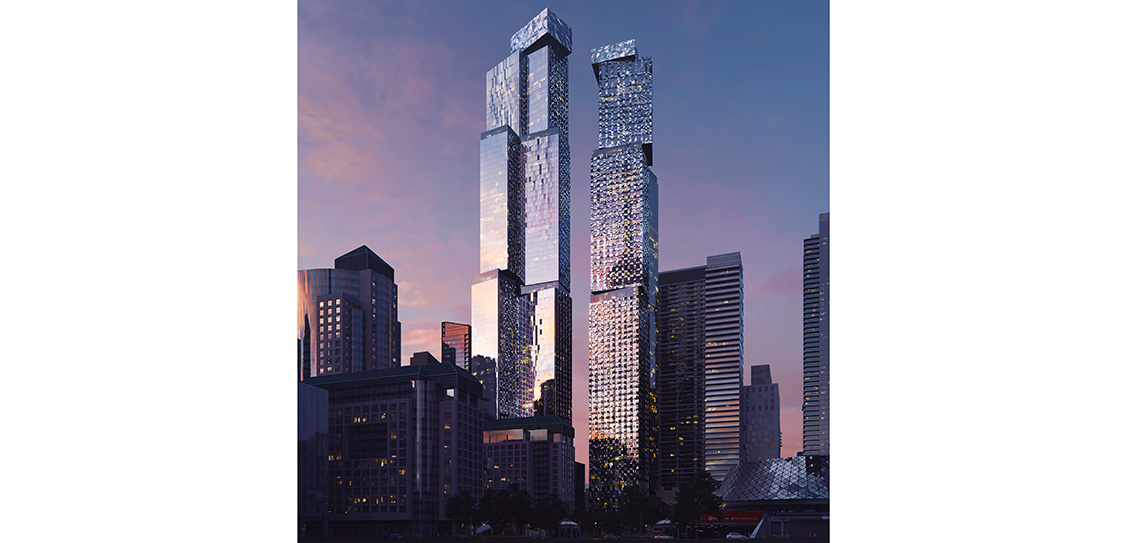Toronto’s two mixed-use towers designed by Frank Gehry revealed
Great Gulf, Westdale Properties and Dream Unlimited showcased refined plans for the project that will be located at the cultural intersection of King Street West and Ed Mirvish Way.
The latest refinements to the design maintain both the height and density that were approved in a 2017 zoning by-law amendment. Specifically, the latest changes adjust the organisation of the towers on the site, enhance the podiums and optimise the floor plates of both towers to offer stunning views from each vantage point in the buildings.
Upon completion, the west tower will be the tallest Gehry designed building in the world. This true mixed-use development will include new space for OCAD University as well as commercial, retail and residential spaces. The changes to the podium incorporate the façade of the heritage Anderson Building which was built in 1915 while respecting the views of both the Royal Alexandra Theatre and the Princess of Wales Theatre, which bookends the project.
Frank Gehry completes France’s twisting geometric structure
Scheduled to open in June 2021, subject to the latest government guidelines in connection with Covid 19, the 27-acre campus at the Parc des Ateliers in Arles brings artists and innovators of the future together.
The 15,000 sq m tower with 11,000 stainless steel panels will house exhibition galleries, project spaces and the Luma Foundation’s research and archive facilities, alongside workshop and seminar rooms. The campus is also home to seven former railway factories, four of which have been renovated by Selldorf Architects as exhibition and performance spaces. The surrounding gardens and public park were designed by landscape architect Bas Smets.
Sharjah’s House of Wisdom by Foster + Partners welcomes its first visitors
Located on the Sharjah International Airport Road, 10 km from the city centre, the two-storey building embodies a sense of clarity and lightness, with a large floating roof cantilevering on all sides of a transparent rectilinear volume.
The 15 m wide overhang shades the façades throughout most of the day, while fixed aluminium screens with differing densities filter the low sun in the evenings. Movable bamboo screens at low levels are deployed by the building users, to provide privacy or to control glare. When not in use the bamboo screens are left open, preserving the visual connections with the landscaped gardens.
First look at NYC’s Waterline Square Park
Mathews Nielsen Landscape Architects’ (MNLA) project spans 2.6 acres at the heart of the residential development, located along the Hudson River waterfront where Midtown meets the Upper West Side.
The park includes more than 200 trees of 20 different species, 65% of which are native to New York. The west end of the development is anchored by conifers and evergreens that mitigate wind and pollution from Riverside Boulevard and aesthetically frame the Hudson River in the distance, while a perennial garden provides native habitats and creates a texture that complements the park's expansive lawn.
Open to the public, the park unifies the buildings of Waterline Square while connecting the nearby waterfront space to the surrounding community. Complete with water features, lush plantings, walking paths and an expansive playground, the park serves at once as a backyard and an oasis, creating a verdant view and serene retreat for residents in the area.
Australia’s winery’s curvaceous design evokes the pouring of wine
Pt Leo Estate Winery by Jolson Architecture and Interiors rises from the ground as an abstract architectural gesture following the curving nature of the site, referencing the process of winemaking and taking on a subtle sculptural quality of its own.
The curvaceous form is an abstract interpretation of wine pouring from a bottle and the organic cycle of the wine harvest. A bold landscaped gesture and design with fluid walls create a strong dialogue with the curvature of Inge King’s iconic sculpture, one of the client’s existing collections. The built form surfaces from the earth, as guests transition through the forecourt the walls which hold back the extended vineyard. In summer months, long tendrils of vine cascade over to veil and anchor the building, reinforcing the design’s response to site and context. It is a building that is of the land and in the land. The cracked granite forecourt surface, together with the asymmetrical placement of the single Bottle Tree is evocative of the Australian rugged, eroded and cracked landscape.



